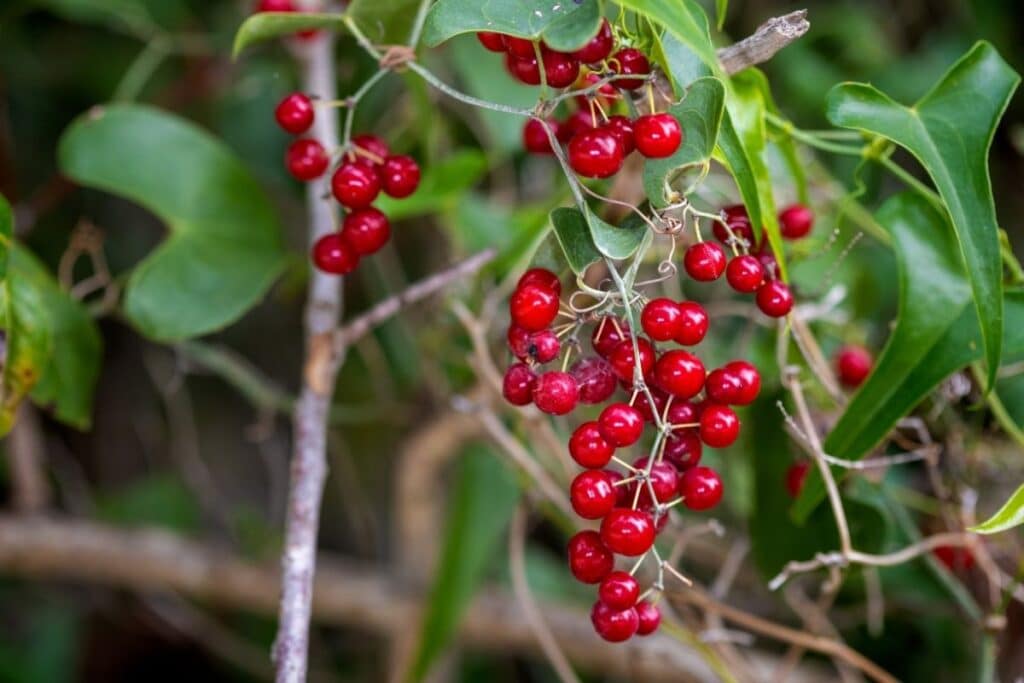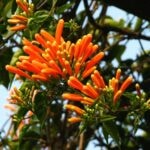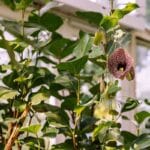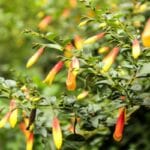The Smilax vine can either put a smile on your face or take it away. As a fast-growing vine, it can easily take over any landscape and become a serious weed problem.
However, the vine can also be used in the landscape as it can capture the attention of the users because of its leaf shape, faint smell, and sharp prickles.
There are several different types of smilax vines you can grow, including wild smilax vines, southern smilax vines (aka Jackson vine), and wild smilax. In this post, our care guidance will be focusing mostly on smilax vines that are categorized as Jackson vine (southern smilax), but know that the care instructions are more or less the same regardless of which common names or varieties you’re dealing with.
So without further ado, let’s get started with our care guide to the southern smilax vine!
Jackson Vine Botanical Information
Coming from the Smilacaceae family, with numerous species of herbaceous and woody vines, the smilax vines are known to be an edible wild plant. It goes by the common names greenbrier, catbrier, sarsaparilla, Jackson vine, bamboo vine, and carrion vine.
Different species are known to be native in Canada, U.S. Virgin Islands, Hawaii, Lower 48 states, and Puerto Rico.
Again, among these, the southern smilax or Jackson vine is perhaps the most common.
Leaves of the Southern Smilax
Looking closely at the smilax vines’ leaves, it has a shiny deep green color with parallel venation. Also, this southern smilax vine can either protect or harm with its prickly stems.
Sometimes, some leaves stay attached even during winter but the leaves that fall tend to leave their leaf stalks connected to the stem. Some caterpillars, such as the Curve-lined owlet moth, use the southern smilax leaves as their host plant.
Flowers of the Southern Smilax
Southern smilax flowers are characterized by their clustered and sphere-like appearance. A wide range of pollinators is attracted to this flower, such as bees and flies. They come not just for the pollen, but also the nectar of the Jackson vine.
Southern Smilax Fruit and Seeds
As the southern smilax vine matures, it produces berries that are spherical and shiny with 1-4 pea-sized seeds inside. The color of the berries can vary from shiny blue-black to red, either color tends to attract humans and animals.
The berries of the southern smilax are edible and rich in fat. It is the main source of food for different species of birds during winter. Sometimes, Black Bears, opossums, foxes, and squirrels take a bite of wild smilax berries!
Growth and Development of Southern Smilax
Greenbriers are perennial vines that grow vastly in any condition. Its versatility can benefit the landscape as it can cover a large space in a small amount of time. The vines crawl anywhere with the help of their specialized plant parts, such as rhizomes and tendrils.
Since this plant needs a short amount of time to grow, it can cause havoc in places where it is not desired.
Grow, Care and Maintenance of the Jackson Vine
Now that you know how to identify southern smilax vines year-round, how do you take care of them? Here are some quick tips.
Sun Requirement
The vine can grow in either full sun, partial shade, or full shade. However, it will be best if exposed to full sun especially if you want the plant to flower.
Water Requirements
The versatility of this plant might surprise you as it can tolerate drought while some species prefer flooded areas.
That said, the southern smilax vine will thrive and perform best year round if you are able to provide it with consistent moisture. Mist it with a water bottle every now and then to give it the water and humidity it needs.
Temperature and Humidity Requirements
The smilax vine can withstand extreme temperatures and weather conditions. Many people get by with keeping their southern smilax vines in an air conditioned room!
While an air conditioned room obviously is not ideal, you can keep your southern smilax indoors year-round without too much of a problem. Warmer temperatures are best to help your Jackson vine thrive, but this is nonetheless a hardy species.
Again, humidity is important, so for the best results of your southern smilax, mist it with a water bottle on a regular basis.
Fertilizer
Fertilizer application is not necessary as long as there is an ample amount of organic matter to support the plant’s growth and development. Most species prefer to grow in areas where the soil is rich in nutrients and organic matter.
Soil Requirements
The smilax vine grows in any soil condition but grows better in well-drained soils. As a crawling vine, if the soil and horizontal space are limited, it is best to provide anchorage such as trellises or dead trees where the vine may cling.
Propagation of Southern Smilax
Reproduction of greenbrier through seeds and plant cuttings is commonly done. In line with this, the application of rooting hormones is beneficial to hasten root production.
On the other hand, using containers or plant pots in propagating the smilax vine through seeds is recommended. While waiting for the seeds to germinate, make sure to put them in a warm shaded place. Keep the soil moist but not too wet. When the greenbrier is ready for transplanting, place a stick or a trellis beside it to have anchorage.
Pruning
Regular pruning for the smilax vine is necessary to keep it in shape and control. Also, the removal of dead plant parts should be regularly done to be less susceptible to pests and diseases. In addition, training the vine is done to keep it in the desired height and shape. However, training the vine may hinder the plant’s flower production.
Potential Dangers of Smilax Vines
The smilax vine is a fast crawler which makes it a tough weed to handle. Reports are saying that even when this vine is burned to the ground, its rhizomes can still germinate and create a new plant. This is why manual weeding or cutting down the plant is not enough as a control measure. Usage of herbicides is recommended to eradicate the vine.
The smilax vine can also cause harm because of its needle-like thorns. Some users of the landscape might get scratches or their clothes might get caught on the prickles.
Uses for Southern Smilax Vines
In the landscape, the southern smilax vine is used to soften some parts by letting it crawl all over different structures and fixtures. It prefers to cling to trees and moist wood. Keeping this in mind, make sure that this vine is placed away from the trees you are growing as it can disrupt the growth of the tree.
Smilax vines also serve as a ground cover.
In terms of edibility, the stems and leaves can be dried and fed to livestock. On the other hand, the rhizomes can be turned into jelly, while the fleshy ones are more textured and can be treated as if they are potatoes. Some incorporate the stem into their salads while the berries are extracted as natural dye or be eaten by wildlife.
Perhaps our favorite use of wild smilax is in root beer. The first American settlers used smilax roots to make root beer. While today’s modern root beer is made from sassafras extract, there is no denying that this smilax vine is versatile in many ways.
Identifying Differences Between Common Species of Smilax Vines
Now that you know what smilax vines are – and how to grow them – how do you tell the different types of smilax vines apart? While most smilax vines that people grow fall into the southern smilax or Jackson vine category, we think it’s important to differentiate between them all.
Here’s a guide.
Less Common Smilax Vines
- Smilax bona-nox: S. bona-nox goes by the name Saw Greenbrier. These species of smilax vines are usually found in woodlands and are differentiated by their rough-textured lower stems and prickles of the main shoot.
- Smilax laurifolia: Found in different areas along rivers, the S. laurifolia is commonly called the Bamboo Vine or Laurel Greenbrier. Some of this species’ of smilax vines’ distinct characteristics are its red petioles and its leaf veins. If observed closely, its leaves have a more noticeable midvein in comparison to the lateral veins.
- Smilax auriculata: S. auriculata is commonly known as the Earleaf Greenbrier and Catbrier. This species prefers sandy soils that’s why it is commonly seen in coastal dunes and disturbed sites. To identify this species of smilax vine, look at the main shoots as it has purple, pink, to salmon-colored lower stems, unlike the petioles.
- Smilax pumila: The Sarsaparilla Vine or S. pumila grows in different parts of the north to central Florida. The stems, petioles, and the underside of the leaves on these smilax vines have tiny hairs which make this species distinct from the others
- Smilax glauca: Commonly known as Cat Greenbrier and Wild Sarsaparilla, the S. glauca prefers to grow in woodlands just like the S. tamnoides and S. bona-nox. Its distinguishing characteristic from other species is its distinct leaf colors. The upper surface of the leaf on these types of smilax vines dark green but the lower surface has a strong gray shade.
- Smilax rotundifolia: Known widely as Bullbrier and Roundleaf Greenbrier, the S. rotundifolia are often seen to grow in temperate areas or areas that have ample amounts of moisture and nutrients such as sides of ponds and wooded lakes. What separates this species of smilax vines from the others is its leaf shape, as it is more rounded or cordate since the leaf tips are short. Sometimes, it has toothed petiole wings.
- Smilax walteri: The Coral Greenbrier or the S. walteri are commonly seen in areas that have stagnant water, which makes it good in flooded areas. Unlike other species, this smilax is deciduous. During winter, its rounded bright red berries continue to be persistent after shedding its leaves.
- Smilax tamnoides: S. tamnoides is commonly called the Bristly Greenbrier smilax vines and Hogbrier. It can be found in areas that are rich in moisture but well-drained, along with S. bona-nox and S. glauca. To identify this species, look closely at its stems and notice that its thorns are needle-like, shiny, and dark-brown to black.
Southern Smilax Vines, aka Jackson Vines or Smilax smallii
And last but certainly not least is the southern smilax, or Jackson vine.
The Southern Smilax Vine, S. smallii is usually referred to as the Jackson Vine and Lanceleaf Greenbrier and grows in well-drained areas.
This wild smilax vine is not fond of flooded areas, therefore providing the right amounts of moisture should be supplied in caring for this plant. To separate this species from the others, check if the leaves do not have a submarginal vein.
Also, its leaves take a narrow oval shape with pointed ends and grow either horizontally or drooping.
Where to Buy Smilax Vines
Now that you know everything that there is to know about growing the exotic, wild smilax vine, how do you find them?
These plants can be tough to find locally. Because of this, you’ll want to order your wild smilax vines online. Try to opt for a shipper that offers FedEx priority overnight shipping (or some overnight shipping service similar to FedEx priority overnight) so that you don’t have to worry about it dying in transit.
Once it arrives, give the plant some time to settle. Keep it relatively warm, at room temperature, and well watered before you plant outdoors or place in a controlled environment like an air conditioned room.
And once your smilax has arrived, you’re ready to get started! Follow the tips above and you’ll be well on your way to enjoying everything this plant has to offer.
FAQs
Finally, check more fast growing climbing vines you can grow.
References
Reference List:
https://edis.ifas.ufl.edu/fr375
https://plants.usda.gov/core/profile?symbol=smila2
https://www.fs.fed.us/database/feis/plants/vine/smirot/all.html
https://florida.plantatlas.usf.edu/Genus.aspx?id=1142
http://www.efloras.org/florataxon.aspx?flora_id=1&taxon_id=130567
https://nwdistrict.ifas.ufl.edu/hort/2015/02/24/smilax-easy-to-find-now-but-hard-to-endure/
Close
*Photo of Smilax aspera (common smilax) by gsafarek/depositphotos







